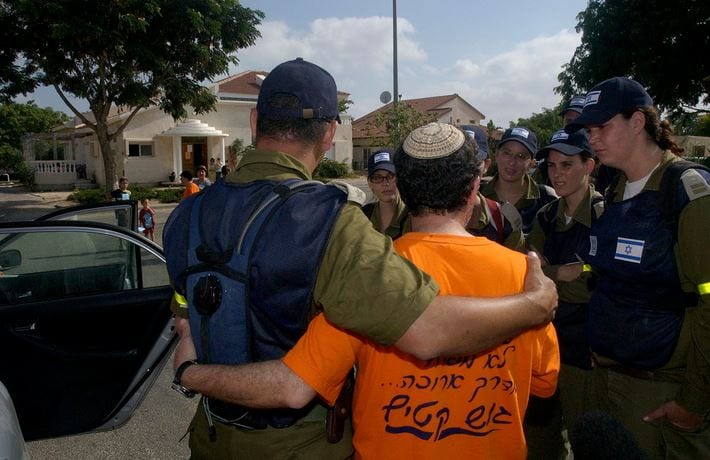Ten years after the Israeli disengagement from Gaza, thousands of former Gush Katif residents are still struggling to rebuild their lives.
Gush Katif, which was a bloc made up of 21 Jewish settlements in the Gaza Strip, was evacuated as part of the 2005 Israeli disengagement plan from Gaza, intended to help pave the way to peace between Israel and the Palestinians.
8,500 people lived and worked in Gush Katif, mainly in agriculture, with hundreds of acres of hothouses that provided a large portion of the country’s crops and flowers. Every single resident were forced out, with their homes and communities destroyed during the withdrawal.
In honor of the 10th anniversary of this difficult event in Israel’s history, the International Young Israel Movement is running a special program this summer. Called 10 Buses for 10 Years, the program brings visitors to meet and speak with former Gush Katif residents, tour the communities where they have rebuilt their homes and lives, and visit the Gush Katif Center, a museum dedicated to the history of the bloc.

Many former residents are still in dire need of help, both material and emotional, but with the passage of time, their plight has faded from public awareness. Yet a large number of them remain even today, 10 years later, without permanent homes or steady income.
Part of the reason why the expulsion is so difficult to cope with, said Oreet Segal, who lived in the Gush Katif community of Ganei Tal, was the loss of the singular spirit of the communities there. “It was a Garden of Eden hiding in the corner of this country,” she said. For kids, especially, “It was an idyllic place to grow up.”
Shlomo Yulis, a former resident of the Gush Katif community Neve Dekalim, echoed Segal’s positive sentiments. He described a paradise in which every resident of the Gush lived and worked together in a caring community that was “like one family.”
“What we had was so special,” he said. “Everyone took care of each other.” When his son became sick with cancer, the entire community pitched in to help, caring for his other children whenever he had to take his son for medical treatments.
Yehudah Gross, who lived in Gush Katif for 23 years before the expulsion, explained that it was “the center of our lives.” He and his wife raised their five children there. “Everything was there – our schools, our businesses, shops, banks, employment.”
As a result, the expulsion was traumatic for many families and children, not to mention the IDF soldiers who were charged with carrying out the orders.
At the Gush Katif Center, images and videos of soldiers and residents in tears, attempting to comfort each other through the ordeal, make painfully clear how incredibly difficult the evacuation was for everyone involved.
Their belongings packed up and shipped away, often to locked containers where they remained inaccessible for months or even years, displaced families were put onto buses and sent out to hotels, tent cities and other temporary housing all over the country.
They were “uprooted and tossed to the wind,” said Segal. “Most people had no idea where they were going. They were dispersed all over the place.”

Many of the residents were relocated to flimsily-built caravans.“They were thrown up, ignoring building codes,” said Segal. “People lived in these boxes for years and years, and people still live there.” Today, 10 years later, approximately 20 percent of evacuees remain in these caravans as they wait for permanent housing.
Some simply cannot afford to build. A huge problem for the evicted residents was, and remains, the inability to get employment. Over half of the former residents have been unable to find work since the expulsion. Most of the Gush Katif residents made a living through agriculture. Without their land and infrastructure, they now have few options.
“Someone aged 50 or 60 who had farmed a certain crop on a certain piece of land for 30 years cannot start a new farm at their age,” said Segal. “And who will hire them?”
Yulis said that the poverty experienced by many evacuees due to the loss of their livelihoods prevented them from rebuilding their lives. “There were people who took out mortgages and loans because they couldn’t feed their children,” he said. With more pressing needs, they were never able to put money aside to build a permanent home.
There also remain a number of evacuees who were not able to cope with the emotional trauma of the disengagement. Several of the residents spoke about friends and neighbors whose spirits simply never recovered. Sinking into depression, some succumbed to illness and early death.

Several organizations have stepped up to help fill the gap still left from the withdrawal, sending food, donations and volunteers to help the families of Gush Katif, and creating programs and events to raise awareness and funds for those still in need. Among them is Karmey Chesed, an Israeli nonprofit organization which runs programs benefiting families and individuals in need of the the basic necessities of life. Karmey Chesed allocates about NIS 1 million a year to help hundreds of Gush Katif families.
“These were hard working people who had their own businesses,” Karmey Chesed founder and director Aryeh Weingarten told Breaking Israel News. “Many were farmers who proudly worked and produced in their own fields. They would help others in need and now things have turned around and they now, still, need help. Many of them do not have homes. Most people from Gush Katif built their own homes, which were destroyed when they were kicked out by the government.”
He added that donations are not the only aid Karmey Chesed provides. “We have dedicated volunteers who work within the Gush Katif population and look for families who are in need to assistance. Whether it’s helping with loans, furniture for homes, clothing, food, 10 years later the people of Gush Katif still need our help.”




